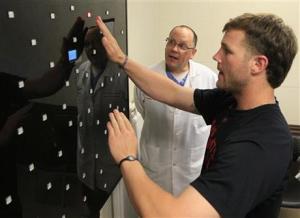
Tony Gwynn, Ted Williams, Pete Rose, Wade Boggs and Ichiro Suzuki are five of the best pure hitters in baseball history. None of them were overly strong but they all possessed exceptional vision at the plate. Hitters have about 0.4 seconds from the time the ball leaves the pitchers hand until it reaches the swing zone. After you figure out what the pitch is, assess the rotation and make a decision whether to swing or not, you are looking at less than 0.2 seconds to hit the ball.
That's why over the past few years, vision training in baseball has become very popular from the professional level down to little leagues where hitters work to quicken their bat speed. If you can speed up your reaction time by just 0.1 seconds, your batting average could dramatically increase.
At the University of Cincinnati, trainers worked with the Bearcats baseball team during the 2011 season using Dynavision's D2 product six weeks prior to the season and then three times per week. What they found was astounding. UC's team average rose by 30 points (from .251 to .285) and their slugging percentage was up 0.033% during the time when they used the Dynavision.
"We tested them on reaction time, hand-eye coordination, peripheral awareness, cognitive focus and visuo-motor skills," said Dynavision CEO Phil Jones, "We were hoping to see an increase in batting average, but a 30 point increase proves how valuable vision training is in baseball."
"They have become more capable of recognizing pitches, especially the spin on breaking pitches and better at being able to study opposing pitchers," said Cincinnati head coach Brian Cleary, "In speaking with our hitters, I've found that they are also believers."
It's been well documented that vision plays an important role in hitting--so why is vision training so effective in baseball? Dr. Joseph F. Clark, PhD. Professor, Department of Neurology, University of Cincinnati is an expert on vision training and oversees the training at the University of Cincinnati. He says the success of baseball players who use vision training, especially the Dynavision, can be broken down into three areas:
1) Focus: Baseball players focus on 60 feet, 6 inches as well as three feet crossing the plate. You only have 0.4 seconds to react so the physical act of looking at a distance, focusing on the distance and moving your eyes and moving your focus – that's two different muscular groups moving in sync. Getting information precisely and accurately in 0.4 seconds is really hard. Vision training allows you to do that faster with more information.
2) Concentration: Dr. Clark intentionally adds distractions during vision training. He does this by using strobe glasses for the baseball players. Clark also runs his training in groups and has the athletes yell out numbers or letters so they generate their own noise in the training. They have to focus and stay in the zone.
3) Information: Vision processing-The Dynavision is good at it. The D2 has a strobe screen that has numbers and information-during the training, Dr. Clark will make the players add number together or call out words. They have to see with their peripheral vision to excel in hand-eye coordination and then call out tasks which is processing. Clark says, "How many times have you seen someone in high school or travel baseball and the coach says check the runner at first and then go home? They may physically check the runner but instead of responding to what the runner was doing, they go home anyway."
"The D2 incrementally advances the batter to higher levels in several areas that are vital to the high level of precision skill required to carry out the guided hitting of a speeding and moving round object with another round object," said Dynavision CEO Phil Jones, "The combination of increasingly precise physical movements and the ability to see the ball coming off of the pitchers hand sooner allows more time for the hitter to make a quicker decision to interpret what he/she sees, decide if it is a ball to be let go (out of the strike zone), swung at, and the type of swing in placing it or slugging it."
Dr. Clark just finished training the Cincinnati baseball team on the Dynavision and will continue a maintenance phase during the season and then summarize our results and see how the senior players are doing compared to the juniors.
According to the Dynavision website, vision training is the new frontier of athletic development set to improve your game in the following ways:
• speed and span of recognition for outfielders to get a jump on the ball
• concentration under stress for better pitching focus and accuracy
• explosive visual reaction for hitters to achieve higher batting averages
• peripheral vision awareness to pick up base runners and avoid fielder collisions
• eye hand coordination for increased infield put outs and less errors
• anticipation timing to react to balls in play by all positions
"One of the freshman said something very interesting," Dr. Clark says, "He said everyone told him that the college pitchers are so much faster but I don't think they are that much faster – that's part of training. Most of the senior players say things like they are picking up the spin of the pitch faster and are more often getting information such as the finger information of the pitchers when they are holding the ball. They are getting more information sooner is the way I interpret that."